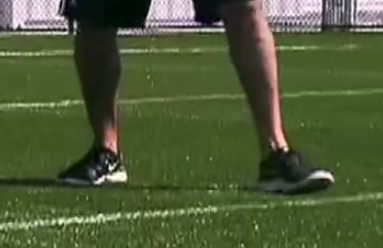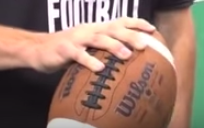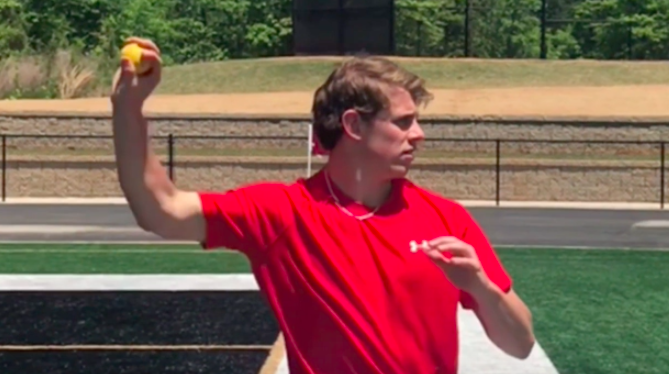The evolution of the passing game has forced quarterbacks to not only be great athletes, but they must be able to throw the ball downfield. Throwing the ball father is a skill that can be taught over time, but how do you throw it far and accurately?
Throwing a football farther requires proper weight transfer of the hips, elastic arm movements, and precise follow-through. A combination of these mechanics will help the ball’s flight and speed go farther.
In this article, we’re going to show you how to throw a football father and more accurate by changing up your mechanics.
Throwing A Football Farther
Sure throwing the ball far is impressive for the camera, but we also want to be accurate with our deep throws. Whether big or small, body sizes can generate power through the arm whip and torque of the hips.
We’re going to break down the simple mechanics of a quarterback and how you can add a few more yards to your throws by simply perfecting footwork, arm slot location, and delivery.
Football Throwing Mechanics
We’re going to cover several mechanical elements of throwing a football. Throwing a football requires proper mechanics and strength to push the ball down the field. These mechanics must be worked on daily to throw the football far and accurately.
Here is what we’re going to cover:
- Footwork
- Grip
- Load Up
- Delivery/Follow Through
It’s important to note that if you want to become a better thrower, perfect each piece of mechanic over time. Throwing a football is not an overnight success; it will take time to get the muscle memory and delivery down, where your body is doing it every time.
Proper Footwork To Throw Farther
Regarding footwork, the lower body should operate in preparing to throw the football, not a baseball or any other sport. The feet should be spaced a little bit wider than shoulder length, and the knees slightly bent. The weight should be distributed on the balls of our feet and ready to move at all times.
We want a base that’s a little bit wider than shoulder length because this allows us to engage just our hips when we throw. Throwing a football is nothing like throwing a baseball; power must be generated from the ground.
Remember, you’re not pushing off a piece of rubber when throwing a football. Generating power is purely from the back leg and back hip.

When throwing the football, our first and only step should be with the front foot by simply opening the front toe 6 inches. As shown in the picture above, here is a great explanation by one of the best to do it, Joe Montana.
It’s important to note that even out of the shotgun, we still want our feet to stay the same length apart, and our footwork remains the same.
See Our Complete List Of Helpful Football Articles Here
Grip When Holding A Football
The grip on the football is another important element to throwing a tight spiral that can cut through the air. Depending on your hand size, you’ll want your grip on the football to be 2 on the laces and 2 off the laces.
If you have a smaller hand, you may need 3 on the laces and 1 off. Regardless, your fingers to be as close to the top of the ball as possible. See the example below.

The importance of having a “pocket of air” between your hand and the football is not shown in the picture. Make there’s a small space between where your hand meets the football.
The grip should fit naturally into your fingers, not so much your palm. Here’s a great video from the University of North Dakota’s coach on throwing a football.
Arm Slot When Throwing A Football
Along with our hips, loading up the football and delivering from the proper arm slot generates power.
Players who play baseball will almost always have a long “reach back” delivery. Shorten the delivery to generate more power and throw the football farther.

Here is a great visual from Adam Britt’s Youtube Channel, QB365. If you haven’t checked out Adam’s videos, I highly recommend you do. He has a complete breakdown and analysis of all things quarterback.
In the picture above, make sure to form the “L” in your throwing motion. This will allow you to sling the elbow through along with the hips to generate power.
To prevent yourself (or your player) from dropping their elbow when they’re throwing the football, make sure they make a “C” with their hand.
You can see in the picture above; the player is making the letter “C” with the ball. It’s the same with a football (just a bit wider because football is bigger). Keep the letter “C” all the way through the delivery until the elbow comes through, forcing your hand to make a “U.”
Follow Through
Once the arm is back and you’ve successfully made all of our letter shapes with the arm, it’s time to throw the ball forward.
Leading with the elbow, we want to create whip and torque from our front foot, hips, and rotation from our upper body to propel the ball downfield. As the football is coming off your hand, emphasize flicking your index finger across your body.
This will give the football a tight spiral as it rotates off the hand. Fast forward to 1:40 in the video below to get a visual example of snapping your thumb down and flicking your index finger.
Few notes about the follow-through:
- Do not swing the back leg to swing around like a pitcher in baseball. It can come up a little bit, but for the most part, the weight should be 70/30 balanced from front foot to back foot.
- Make sure your front shoulder is pointing to your target. It doesn’t have to be exactly to where you’re throwing, but we want it in the general direction
- Film yourself to get a better understanding of the mechanics. The only way to get better is to feel and visually see yourself throwing the football. Especially if you don’t have a private coach, you can fix yourself by simply following the details in this article
Throwing Mechanic Drills To Throw Farther
We recommend starting slow by working on just your grip and arm slot to start.
Once you start to feel comfortable, move to the next progression. Once we start to feel comfortable, let’s start to move forward with hitting moving targets. Have friend run routes within 5 yards ( no deep throws initially), that way; you can work on your accuracy. Have 3 footballs ready to go at all times to maximize reps.
Remember, the more reps, the better you’re trying to tap into your muscle memory to have the same throw every time.
Now that our accuracy is starting to improve, start to move the receivers deeper downfield. Cutting both in/out and vertically.
Once you’ve established your short-range accuracy, now you can start throwing the ball downfield to receivers. After you feel comfortable throwing the short, intermediate, and deep throws, start to move the pocket as if you’re being rushed.
Footwork inside the pocket is what separates a good passer from a great passer. Record your footwork to ensure that your feet always stay at shoulder width, even inside the pocket.
Here are some great pocket drills from the University of Washington’s Coach. Skip to 3:40 to watch pocket presence drills.
Conclusion
Throwing the football far and accurate requires proper lower body and upper body mechanics. It’s important to focus early on the mechanics before worrying about the arm strength. As the player gets older, naturally, they will get stronger.
Arm power is a great asset, but if you’re wild with your throws (over the head or even too wide), then your strong arm is useless to the receivers.
Practice these mechanics every day, even in the offseason, to maximize your consistency. If you have any questions about throwing a football, send us a DM on Instagram @gethypedfootball.
